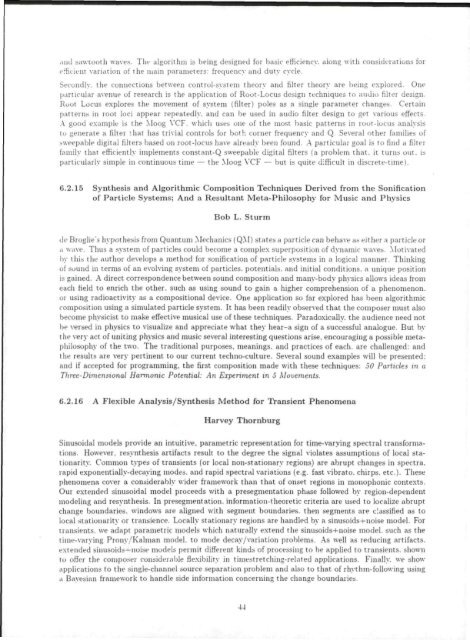Download - CCRMA - Stanford University
Download - CCRMA - Stanford University
Download - CCRMA - Stanford University
You also want an ePaper? Increase the reach of your titles
YUMPU automatically turns print PDFs into web optimized ePapers that Google loves.
.ind sawtooth waves. The algorithm is being designed for basic efficiency, along with considerations for<br />
efficient variation of the main parameters: frequency and duty cycle.<br />
Secondly, the connections between control-system theory and filter theory are being explored. One<br />
particular avenue of research is the application of Root-Locus design techniques to audio filter design.<br />
Root Locus explores the movement of system (filter) poles as a single parameter changes. Certain<br />
patterns in root loci appear repeatedly, and can be used in audio filter design to get various effects<br />
A good example is the Moog VCF. which uses one of the most basic patterns in root-locus analysis<br />
tu generate a filter '.hat has trivial controls for both corner frequency and Q. Several other families of<br />
>weepable digital filters based on root-locus have already been found. A particular goal is to find a filter<br />
family that efficiently implements constant-Q sweepable digital filters (a problem that, it turns out. is<br />
particularly simple in continuous time — the Moog VCF — but is quite difficult in discrete-time).<br />
6.2.15 Synthesis and Algorithmic Composition Techniques Derived from the Sonification<br />
of Particle Systems; And a Resultant Meta-Philosophy for Music and Physics<br />
Bob L. Sturm<br />
de Broglie's hypothesis from Quantum Mechanics (QM) states a particle can behave as either a particle or<br />
a wave. Thus a system of particles could become a complex superposition of dynamic waves. Motivated<br />
by this the author develops a method for sonification of particle systems in a logical manner. Thinking<br />
of sound in terms of an evolving system of particles, potentials, and initial conditions, a unique position<br />
is gained. A direct correspondence between sound composition and many-body physics allows ideas from<br />
each field to enrich the other, such as using sound to gain a higher comprehension of a phenomenon.<br />
or using radioactivity as a compositional device. One application so far explored has been algorithmic<br />
composition using a simulated particle system, h has been readily observed that the composer must also<br />
become physicist to make effective musical use of these techniques. Paradoxically, the audience need not<br />
be versed in physics to visualize and appreciate what they hear-a sign of a successful analogue. But by<br />
the very act of uniting physics and music several interesting questions arise, encouraging a possible metaphilosophy<br />
of the two. The traditional purposes, meanings, and practices of each, are challenged: and<br />
the results are very pertinent to our current techno-culture. Several sound examples will be presented:<br />
and if accepted for programming, the first composition made with these techniques: 50 Particles in a<br />
Three-Dimensional Harmonic Potential: An Experiment in 5 Movements.<br />
6.2.16 A Flexible Analysis/Synthesis Method for Transient Phenomena<br />
Harvey Thornburg<br />
Sinusoidal models provide an intuitive, parametric representation for time-varying spectral transformations.<br />
However, resynthesis artifacts result to the degree the signal violates assumptions of local stationary.<br />
Common types of transients (or local non-stationary regions) are abrupt changes in spectra,<br />
rapid exponentially-decaying modes, and rapid spectral variations (e.g. fast vibrato, chirps, etc.). These<br />
phenomena cover a considerably wider framework than that of onset regions in monophonic contexts.<br />
Our extended sinusoidal model proceeds with a presegmentation phase followed by region-dependent<br />
modeling and resynthesis. In presegmentation. information-theoretic criteria are used to localize abrupt<br />
change boundaries, windows are aligned with segment boundaries, then segments are classified as to<br />
local stationarity or transience. Locally stationary regions are handled by a sinusoids-i-noise model. For<br />
transients, we adapt parametric models which naturally extend the sinusoids-l~noise model, such as the<br />
time-varying Prony/Kalman model, to mode decay/variation problems. As well as reducing artifacts,<br />
extended sinusoids—noise models permit different kinds of processing to be applied to transients, shown<br />
to offer the composer considerable flexibility in timestretching-related applications. Finally, we show<br />
applications to the single-channel source separation problem and also to that of rhythm-following using<br />
a Bayesian framework to handle side information concerning the change boundaries.<br />
44

















